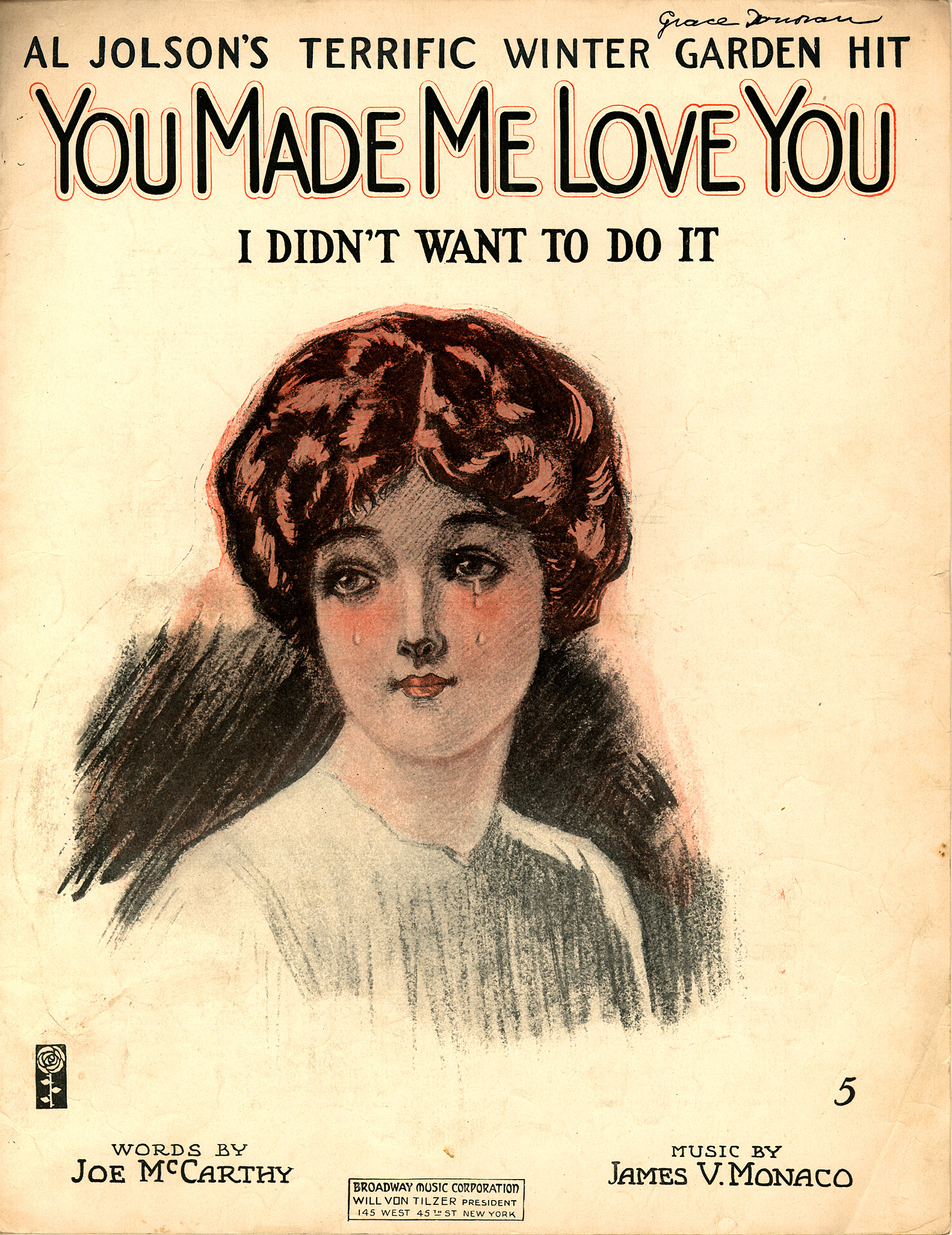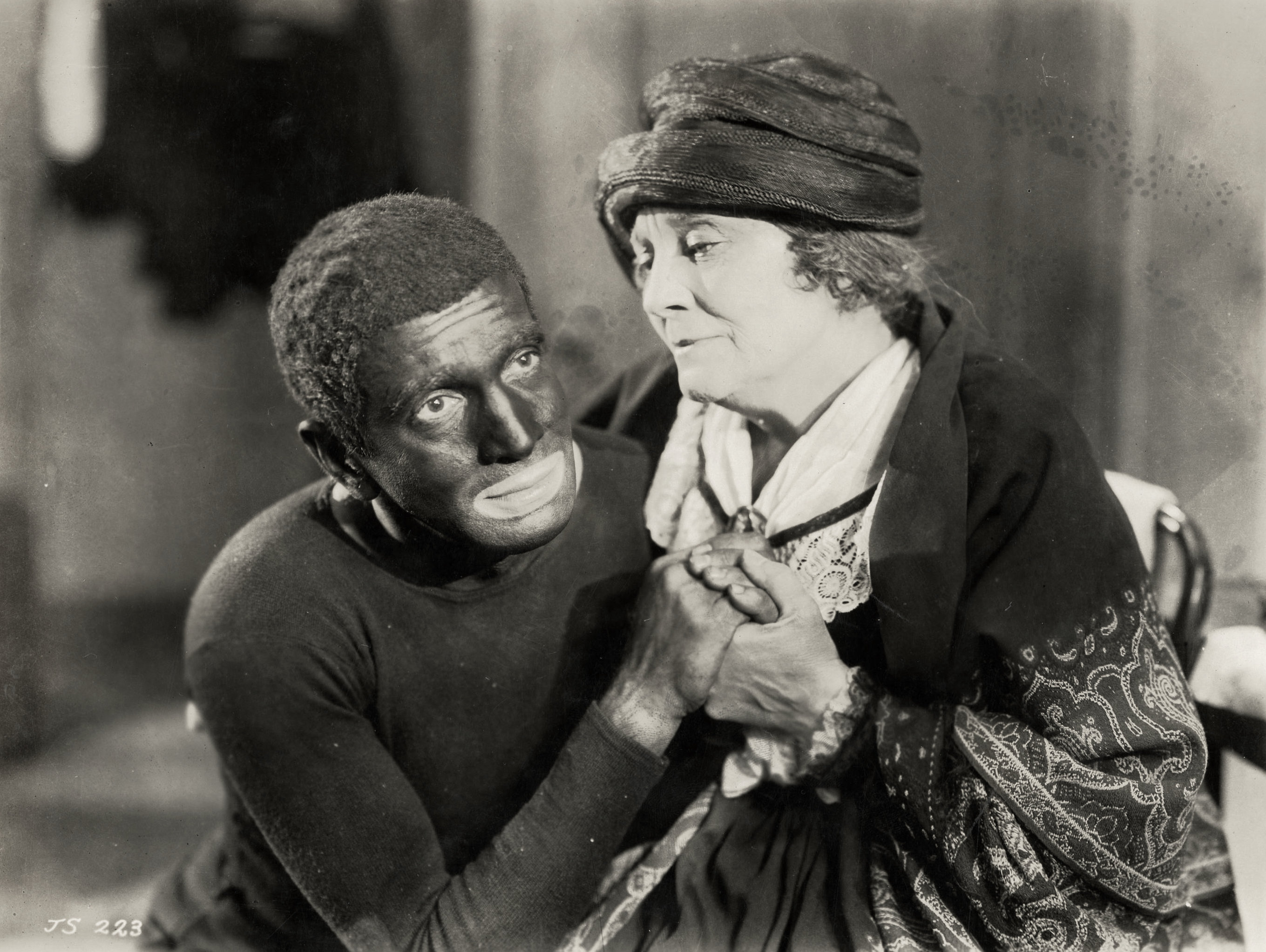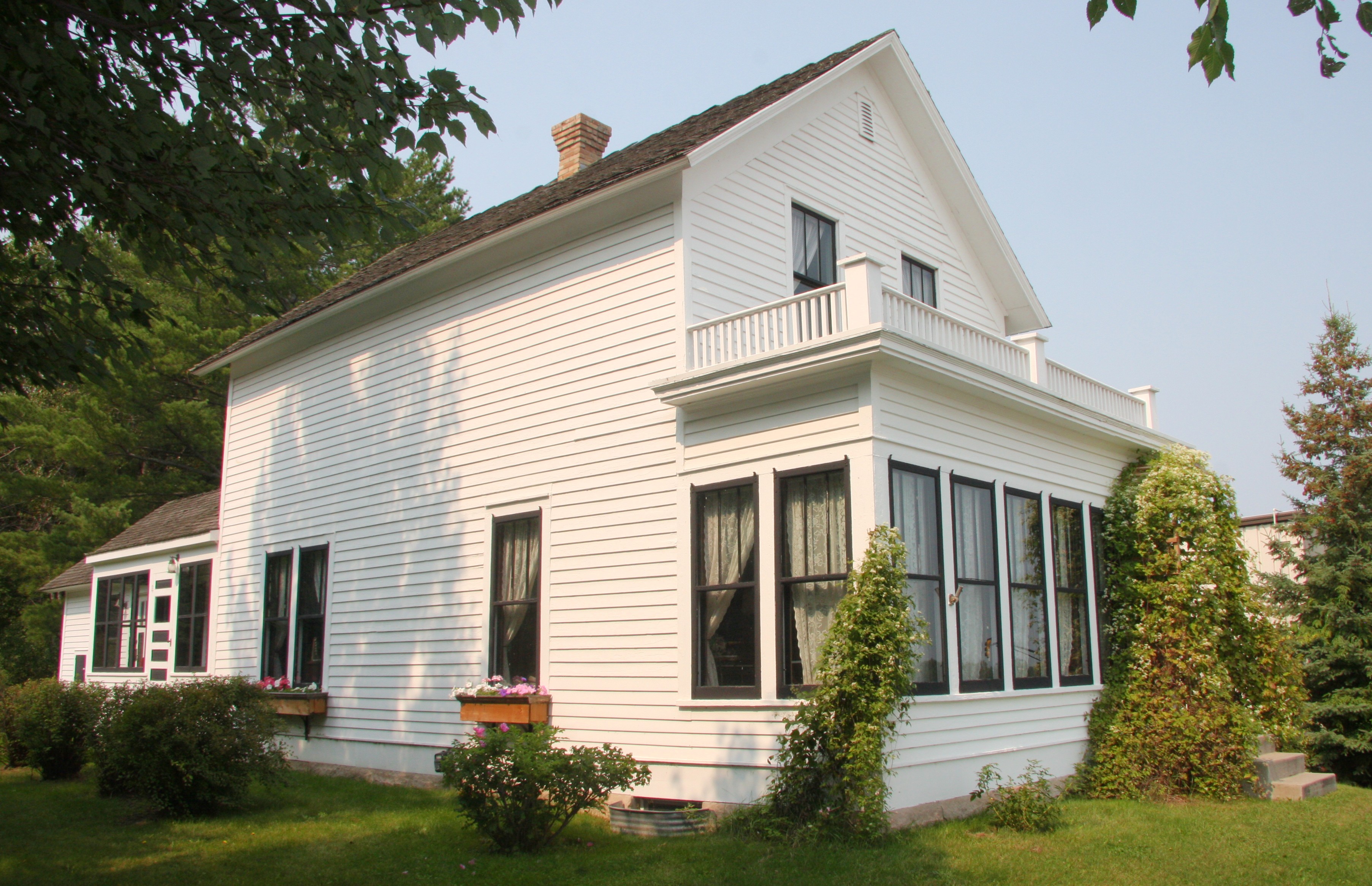|
James V. Monaco
James Vincent Monaco (January 13, 1885 – October 16, 1945) was an Italian-born American composer of popular music. Life and career Monaco was born in Formia, Italy. His family emigrated to the United States when he was six, and he grew up in Albany, New York, where he started playing piano in bars by the age of 18. He relocated to Chicago, where he became known as "Ragtime Jimmie", before moving to New York City in 1910. He played piano at cafes in Manhattan and at Coney Island, and wrote his first successful song, "Oh, You Circus Day", which was featured in a Broadway revue, ''Hanky Panky'', in 1911. Further success came the following year with "Row, Row, Row" (lyrics by William Jerome) in the '' Ziegfeld Follies of 1912'', and perhaps his best remembered song, "You Made Me Love You (I Didn't Want to Do It)" (lyrics by Joseph McCarthy), introduced by Al Jolson in 1913 and performed by Judy Garland with revised lyrics as "Dear Mr Gable" in 1937. In 1914, Monaco became a ... [...More Info...] [...Related Items...] OR: [Wikipedia] [Google] [Baidu] |
Formia
Formia is a city and ''comune'' in the province of Latina, on the Mediterranean coast of Lazio, Italy. It is located halfway between Rome and Naples, and lies on the Roman-era Appian Way. It has a population of 38,095. Istat 2017 History The city of Formia was originated by the Italic population of the Aurunci. It appeared for the first time in history in 338 BC, when, during the Latin Wars, it received the Civitas sine suffragio, together with the city of Fondi. Throughout antiquity, the city of Caieta was also part of the Formian territory. In the Roman Republic era it was called ''Formiae'' (derived from ''Hormia'' or ''Ormiai'', for its excellent landing). It was a renowned resort during the imperial era and Horace calls it "the city of the Mamurrae" as the rich and noble equestrian family of Mamurra had stong interests there, including the villa-estate nearby at Gianola which can still be seen. Cicero also had a villa there and he was assassinated on the Appian ... [...More Info...] [...Related Items...] OR: [Wikipedia] [Google] [Baidu] |
William Jerome
William Jerome Flannery, September 30, 1865 – June 25, 1932) was an American songwriter, born in Cornwall-on-Hudson, New York of Irish immigrant parents, Mary Donnellan and Patrick Flannery. He collaborated with numerous well-known composers and performers of the era but is best remembered for his decade-long association with Jean Schwartz with whom he created many popular songs and musical shows in the 1900s and early 1910s. Early career By the time he was seventeen, Jerome was singing and dancing in vaudeville. He toured with minstrel shows and performed in blackface. He met Eddie Foy while on tour and they became friends; the two would work together often throughout their careers. By the late 1880s Jerome was performing as a parody-singer at Tony Pastor's. He also began to write songs and his efforts met with some success. In 1891, Jerome composed "He Never Came Back", sung by Foy in the musical '' Sinbad'', which became the hit of the show. Throughout the 1890s he con ... [...More Info...] [...Related Items...] OR: [Wikipedia] [Google] [Baidu] |
The Jazz Singer
''The Jazz Singer'' is a 1927 American musical drama film directed by Alan Crosland. It is the first feature-length motion picture with both synchronized recorded music score as well as lip-synchronous singing and speech (in several isolated sequences). Its release heralded the commercial ascendance of sound films and effectively marked the end of the silent film era. It was produced by Warner Bros. with the Vitaphone sound-on-disc system and features six songs performed by Al Jolson. Based on the 1925 play of the same title by Samson Raphaelson, the plot was adapted from his short story "The Day of Atonement". The film depicts the fictional story of Jakie Rabinowitz, a young man who defies the traditions of his devout Jewish family. After singing popular tunes in a beer garden, he is punished by his father, a hazzan (cantor), prompting Jakie to run away from home. Some years later, now calling himself Jack Robin, he has become a talented jazz singer, performing in blackfa ... [...More Info...] [...Related Items...] OR: [Wikipedia] [Google] [Baidu] |
Edgar Leslie
Edgar Leslie (December 31, 1885 – January 22, 1976) was an American songwriter. Biography Edgar Leslie was born in Stamford, Connecticut, in 1885. He studied at the Cooper Union in New York. He published his first song in 1909, starting a long prolific career as a composer and lyricist. He died in 1976. Musical career Leslie's first song, "Lonesome" (1909), was an immediate success, recorded by the Haydn Quartet and again by Byron G. Harlan. Other notable artists recorded his early works. Among them were Nat M. Wills, Julian Rose, Belle Baker, Lew Dockstader, James Barton and Joe Welch. A founding member of ASCAP in 1914. In 1927, he traveled to England and collaborated with Horatio Nicholls on several songs, most notably "Among My Souvenirs". Leslie served as its director from 1931 to 1941 and from 1947 to 1953. His most enduring success of the era was probably 1935's " Moon Over Miami". He was inducted into the Songwriters Hall of Fame in 1972. [...More Info...] [...Related Items...] OR: [Wikipedia] [Google] [Baidu] |
Grant Clarke
Grant Clarke (May 14, 1891, Akron, Ohio – May 16, 1931, California) was an American songwriter. Clarke moved to New York City early in his career, where he worked as an actor and a staff writer for comedians. He began working on Tin Pan Alley, where he contributed music to films such as ''The Jazz Singer'' (1927), ''Weary River'' (1928), '' On with the Show'' (1929) and '' Is Everybody Happy?'' (1929). He wrote the lyrics to the show '' Dixie to Broadway'', and also contributed to the 1921 ''Ziegfeld Follies'' and ''Bombo''. Later in his career he became a charter member of ASCAP and was successful in the music publishing business. Clarke was the author of the lyrics to many popular songs of the 1910s and 1920s, working with composers such as George W. Meyer, Harry Akst, James V. Monaco, Al Piantadosi, Fred Fisher, Harry Warren, Arthur Johnston, James Hanley, Lewis F. Muir and Milton Ager. Selected songs A list of Clarke's most prominent works: * "Dat's Harmony" (1911) * "Ra ... [...More Info...] [...Related Items...] OR: [Wikipedia] [Google] [Baidu] |
Dirty Hands, Dirty Face
"Dirty Hands, Dirty Face" (or "Dirty Hands! Dirty Face!") is a song from the 1921 musical ''Bombo''. The lyrics were written by Grant Clarke and Edgar Leslie; with music by James V. Monaco. Al Jolson is often credited as a lyricist; it was common for popular performers to take a cut of the popularity of a song by being listed as a lyricist. The song is about the love that a father has for his son. Jolson version Jolson performs the song in the 1927 film ''The Jazz Singer'' in character as Jack Robin (formerly Jakie Rabinowitz). The film concerns the attempt of Jolson's character to become a vaudeville performer against opposition from his religious Jewish family. It was the film's second musical number, and occurs 18 minutes into the film in a scene at Coffee Dan's nightclub in San Francisco. Jolson subsequently recorded the song in March 1928. Gerald R. Butters in his 2002 book ''Black Manhood on the Silent Screen'' wrote that "the symbolic link with blackface (dirtiness) is obvi ... [...More Info...] [...Related Items...] OR: [Wikipedia] [Google] [Baidu] |
Howard Johnson (lyricist)
Howard Johnson (June 2, 1887 – May 1, 1941) was a song lyricist. He was inducted into the Songwriters Hall of Fame in 1970. Biography Songwriter, author and lyricist, Johnson was born in Waterbury, Connecticut, and died in New York, New York. He was educated in high school and in private music study. Johnson was a pianist in Boston theatres, and then a staff writer for a New York publishing company. During World War I, he served in the United States Navy. Joining the American Society of Composers, Authors and Publishers (ASCAP) in 1917, his chief musical collaborators included Milton Ager, Walter Donaldson, Fred Fisher, George Meyer, Joseph Meyer, Jimmy Monaco, Al Sherman, Harry Warren, Percy Wenrich, Harry M. Woods, David Brockman, Archie Gottler, James Kendis, and W. Edward Breuder. Johnson's most well-known song is "I Scream, You Scream, We All Scream for Ice Cream." Some popular-song compositions include: "When the Moon Comes over the Mountain", "M-O-T-H-E-R, A Word Th ... [...More Info...] [...Related Items...] OR: [Wikipedia] [Google] [Baidu] |
What Do You Want To Make Those Eyes At Me For?
"What Do You Want to Make Those Eyes at Me For?" is a song written by Joseph McCarthy, Howard Johnson and James V. Monaco in 1916 for the Broadway production ''Follow Me'', in which it was performed by Henry Lewis. Early recordings Lewis' version was released as a single on Emerson Records in early 1917. Around the same time, a version by Sam Ash was released in February on Columbia Records, having been recorded on 11 December 1916. It was first a hit when released in March that year by Ada Jones and Billy Murray on Victor Records, peaking at number 3 on the US ''Billboard'' chart. Emile Ford and the Checkmates version The song became a UK hit in 1959 when a doo-wop version was recorded by Emile Ford and the Checkmates as the B-side of their single "Don't Tell Me Your Trouble". This B-side became more popular and it topped the charts for six weeks over the Christmas and New Year of 1959/60. It retained the number one position for the first three weeks of 1960. This earned Fo ... [...More Info...] [...Related Items...] OR: [Wikipedia] [Google] [Baidu] |
Tin Pan Alley
Tin Pan Alley was a collection of music publishers and songwriters in New York City that dominated the popular music of the United States in the late 19th and early 20th centuries. It originally referred to a specific place: West 28th Street between Fifth and Sixth Avenues in the Flower District of Manhattan; a plaque (see below) on the sidewalk on 28th Street between Broadway and Sixth commemorates it. In 2019, the New York City Landmarks Preservation Commission took up the question of preserving five buildings on the north side of the street as a Tin Pan Alley Historic District. The agency designated five buildings (47–55 West 28th Street) individual landmarks on December 10, 2019, after a concerted effort by the "Save Tin Pan Alley" initiative of the 29th Street Neighborhood Association. Following successful protection of these landmarks, project director George Calderaro and other proponents formed the Tin Pan Alley American Popular Music Project to continue and com ... [...More Info...] [...Related Items...] OR: [Wikipedia] [Google] [Baidu] |
American Society Of Composers, Authors And Publishers
The American Society of Composers, Authors, and Publishers (ASCAP) () is an American not-for-profit performance-rights organization (PRO) that collectively licenses the public performance rights of its members' musical works to venues, broadcasters, and digital streaming services (music stores). ASCAP collects licensing fees from users of music created by ASCAP members, then distributes them back to its members as royalties. In effect, the arrangement is the product of a compromise: when a song is played, the user does not have to pay the copyright holder directly, nor does the music creator have to bill a radio station for use of a song. In 2021, ASCAP collected over US$1.335 billion in revenue and distributed $1.254 billion in royalties to its members. ASCAP membership included over 850,000 songwriters, composers and music publishers, with over 16 million registered works. History ASCAP was founded by Victor Herbert, together with composers George Botsford, Silvio Hein, I ... [...More Info...] [...Related Items...] OR: [Wikipedia] [Google] [Baidu] |
Judy Garland
Judy Garland (born Frances Ethel Gumm; June 10, 1922June 22, 1969) was an American actress and singer. While critically acclaimed for many different roles throughout her career, she is widely known for playing the part of Dorothy Gale in '' The Wizard of Oz'' (1939). She attained international stardom as an actress in both musical and dramatic roles, as a recording artist and on the concert stage. Renowned for her versatility, she received an Academy Juvenile Award, a Golden Globe Award and a Special Tony Award. Garland was the first woman to win the Grammy Award for Album of the Year, which she won for her 1961 live recording titled ''Judy at Carnegie Hall''. Garland began performing as a child with her two older sisters, in a vaudeville group " The Gumm Sisters" and was later signed to Metro-Goldwyn-Mayer as a teenager. She appeared in more than two dozen films for MGM. Garland was a frequent on-screen partner of both Mickey Rooney and Gene Kelly and regularly collaborated w ... [...More Info...] [...Related Items...] OR: [Wikipedia] [Google] [Baidu] |
Al Jolson
Al Jolson (born Eizer Yoelson; June 9, 1886 – October 23, 1950) was a Lithuanian-American Jews, Jewish singer, comedian, actor, and vaudevillian. He was one of the United States' most famous and highest-paid stars of the 1920s, and was self-billed as "The World's Greatest Entertainer." Jolson was known for his "shamelessly sentimental, melodramatic approach" towards performing, as well as for popularizing many of the songs he sang. Jolson has been referred to by modern critics as "the king of blackface performers." Although best remembered today as the star of the first talking picture, ''The Jazz Singer'' (1927), he starred in a series of successful musical films during the 1930s. After the attack on Pearl Harbor in December 1941, he was the first star to entertain troops overseas during World War II. After a period of inactivity, his stardom returned with ''The Jolson Story'' (1946), in which Larry Parks played Jolson, with the singer dubbing for Parks. The formula was repeat ... [...More Info...] [...Related Items...] OR: [Wikipedia] [Google] [Baidu] |

.jpg)






.png)

